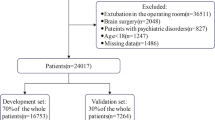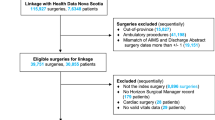Abstract
Objective
In anesthesia and intensive care logistic regression analysis are often used to generate predictive models for risk assessment. Strictly seen only independent variables should be represented in such prognostic models. Using anesthesia-information-management-systems a lot of (depending) information is stored in a database during the preoperative ward round. The objective of this study was to evaluate a statistical algorithm to process the different dependent variables without losing the information of each variable on patient’s conditions.
Method
Based on data about prognostic models in anesthesia an iterative statistical algorithm was initiated to summarize dependent variables to subscores. Seven subscores out of several preoperative variables were calculated corresponding to the proper incidence and the correlation to the occurrence of intraoperative cardiovascular events was evaluated. After that first step logistic regression was used to build a predictive model out of the seven subscores, 10 patient-related, and two surgery-related variables. Performance of the prognostic model was assessed using analysis of discrimination and calibration.
Result
Four out of seven subscores together with age, type and urgency of surgery are represented in the prognostic model to predict the occurrence of intraoperative cardiovascular events. The prognostic model demonstrated good discriminative power with an area under the ROC curve (AUC) of 0.734.
Conclusion
Due to reduced calibration, the clinical use of the prediction model is limited.
Similar content being viewed by others
References
Sachs L (1997) Angewandte Statistik. 8 ed. Berlin, Heidelberg, New York: Springer-Verlag
Benson M, Junger A, Quinzio L, Fuchs C, Sciuk G, Michel A et␣al. (2000) Clinical and practical requirements of online software for anesthesia documentation an experience report. Int J Med Inf 57(2–3):155–164
Röhrig R, Junger A, Hartmann B, Klasen J, Quinzio L, Jost A et␣al. (2004) The incidence and prediction of automatically detected intraoperative cardiovascular events in noncardiac surgery. Anesth Analg 98(3):569–577
DGAI-Kommission Qualitätssicherung und Datenverarbeitung in der Anästhesie. Kerndatensatz Qualitätssicherung in der Anästhesie. Anästh Intensivmed 1993; 34: 331–335
Hanley JA, McNeil BJ (1982) The meaning and use of the area under a receiver operating characteristic (ROC) curve. Radiology 143(1):29–36
Hosmer DW, Lemeshow S (1989) Applied logistic regression. New York: John Wiley & Sons Inc
Goldman L, Caldera DL, Nussbaum SR, Southwick FS, Krogstad D, Murray B et␣al. (1977) Multifactorial index of cardiac risk in noncardiac surgical procedures. N Engl J Med 297(16):845–850
Detsky AS, Abrams HB, Forbath N, Scott JG, Hilliard JR, et al (1986) Cardiac assessment for patients undergoing noncardiac surgery. A multifactorial clinical risk index. Arch Intern Med 146(11):2131–2134
Lee TH, Marcantonio ER, Mangione CM, Thomas EJ, Polanczyk CA, Cook EF et␣al. (1999) Derivation and prospective validation of a simple index for prediction of cardiac risk of major noncardiac surgery. Circulation 100(10):1043–1049
Forrest JB, Rehder K, Cahalan MK, Goldsmith CH, et al (1992) Multicenter study of general anesthesia. III. Predictors of severe perioperative adverse outcomes. Anesthesiology 76:3–15
Cohen MM, Duncan PG, Tate RB, et al (1988) Does anesthesia contribute to operative mortality? JAMA 260(19):2859–2863
Sanborn KV, Castro J, Kuroda M, Thys DM, et al (1996) Detection of intraoperative incidents by electronic scanning of computerized anesthesia records. Comparison with voluntary reporting. Anesthesiology 85(5):977–987
Fowkes FG, Lunn JN, Farrow SC, Robertson IB, Samuel P (1982) Epidemiology in anaesthesia. III: Mortality risk in patients with coexisting physical disease. Br J Anaesth 54(8):819–825
Pedersen T, Eliasen K, Henriksen E (1990) A prospective study of mortality associated with anaesthesia and surgery: Risk indicators of mortality in hospital. Acta Anaesthesiol Scand 34(3):176–182
Farrow SC, Fowkes FG, Lunn JN, Robertson IB, Sweetnam P (1984) Epidemiology in anaesthesia: A method for predicting hospital mortality. Eur J Anaesthesiol 1(1):77–84
Schwilk B, Muche R, Treiber H, Brinkmann A, Georgieff M, Bothner U, et al (1998) A cross-validated multifactorial index of perioperative risks in adults undergoing anaesthesia for non-cardiac surgery. J Clin Monit 14:283–294
Acknowledgement
Statistical analysis was performed in cooperation with MoReData GmbH in Giessen, Germany.
Financial support for this study was provided in part by a grant from IMESO GmbH, Hüttenberg, Germany. The founding agreement ensured the authors’ independence in designing the study, interpreting the data, writing and publishing the report.
Author information
Authors and Affiliations
Corresponding author
Additional information
Röhrig R, Hartmann B, Junger A, Klasen J, Brammen D, Brenck F, Jost A, Hempelmann G. Corrected incidences of co-morbidities – a statistical approach for risk-assessment in anesthesia using an AIMS
J Clin Monit Comput 2007
Rights and permissions
About this article
Cite this article
Röhrig, R., Hartmann, B., Junger, A. et al. Corrected incidences of co-morbidities – a statistical approach for risk-assessment in anesthesia using an AIMS. J Clin Monit Comput 21, 159–166 (2007). https://doi.org/10.1007/s10877-007-9070-3
Received:
Accepted:
Published:
Issue Date:
DOI: https://doi.org/10.1007/s10877-007-9070-3




